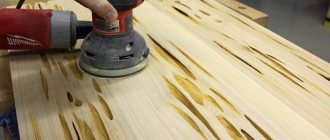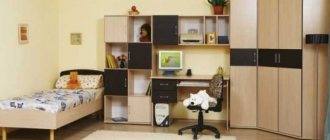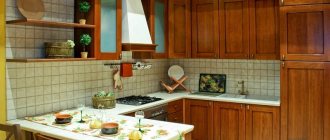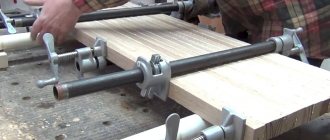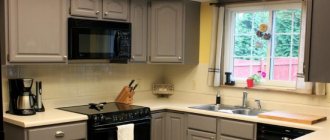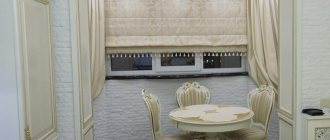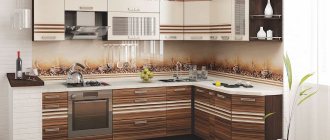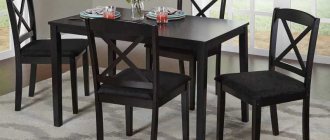pros
Countertops made of natural wood have many positive qualities:
- Environmental friendliness. Unlike laminated chipboard or other particle boards, solid oak or other wood is completely safe: no glue, resins or other substances are used in its production.
- Texture. Just as you cannot find two identical fingerprints, you cannot find identical patterns on saw cuts. You can be sure: your countertop is unique!
- Ease of processing. For users, this means that a wooden tabletop can be made to any size and shape. Cuts and milling are also available.
- Possibility of updating. If you scratch the laminated surface, you can only replace it with a new one. The wood can be easily sanded down, coated with wax again and it will serve you for many more years! By the way, the shade of the coating is also easy to change using processing: light pine can be turned into dark walnut in just one movement.
Important! Over the years, the tree only gets better: it develops character, accumulates density and strength.
The photo shows a modern set with an island
Wooden kitchen countertop
To create an original kitchen interior, it is not at all necessary to order furniture according to an individual project. You can make a kitchen countertop from wood yourself.
In order for you to get a beautiful wooden tabletop, it is important to choose the right material, familiarize yourself with the installation rules and the features of caring for the finished product.
Minuses
Solid wood countertops have several disadvantages:
- Difficult care. Everything is relative, but if laminated chipboard can simply be wiped with a cloth, then the wood coating should be renewed every few months: wax or oil is scraped out and evaporates during use. The exception is varnish, but scratches form on it.
- High price. And again, everything is relative: compared to “artificial” materials, wood is not cheap, but it will also last you much longer. But it is 2 times cheaper than stone.
Useful tips when choosing wood
When choosing a wooden countertop, you should pay attention to the characteristics of the material. You can find them out from a consultant or even find information on the Internet. Here are some of the important parameters:
- heat resistance level;
- humidity level - does not exceed 12%;
- moisture resistance . This point is especially worth highlighting. After all, if you do not pay attention to this, you may encounter a number of problems due to high humidity. The best according to this parameter are considered to be boards made of spruce, pine, birch, oak, and larch;
- wood density . Due to its softness, the material is susceptible to mechanical damage, which obviously will not please you;
- appearance . Well, without this, of course, there’s nowhere. Every time you work, you will see in front of you what you have chosen. Therefore, treat this with taste and care. For example, you should discard the material if it has wormholes, rotten knots or resin pockets - these will affect not only the appearance, but also the quality of the tabletop.
You can also cover the wooden tabletop with an additional protective layer yourself. This can be done both to restore old characteristics, as well as to create higher strength.
There are several lifehacks for choosing the ideal product that professionals share:
- If the tabletop needs to be milled or simply sawed not in a straight line, then you need to take only 100% wood. Consultants may suggest chipboard or MDF with veneer, but the result after cutting will be completely different. In addition, wood can be restored an infinite number of times, but veneer will survive only a few restorations.
- If wear resistance is important, then it is better to look towards oak or larch. Yes, they are expensive, but since the structure of the rock is dense, there will be no restrictions on the service life of such a countertop. They are not afraid of mechanical influences, moisture, temperature. In addition, larch costs 1.5 times less than oak, and contains gum - a natural antiseptic that prevents mold.
- If budget is an issue, then you should pay attention to walnut, ash, beech or birch. Of course, spruce and pine will delight you with even more reasonable price tags, but these species are too soft, so they will immediately become covered with small dents.
- If you have a strong desire to save money, then you can take a thin tabletop, only 20 mm thick. But you need to treat it very carefully and not place heavy objects.
- A very practical point - every speck of dust and speck will be visible on a dark tree, so oak and walnut should be chosen only by neat people who like to wipe the dust several times a day. And for everyone else, elm, beech, and birch are perfect.
- The depth of the countertop should be 3–5 centimeters greater than the depth of the floor cabinets - this will protect against impacts on the handles and surface.
- The best option for a sink is a mortise sink. In this case, a hole is made in the countertop, onto which a sink is placed on top. All joints must be treated with sealant or glue. Although a sink with an under-table installation will look impressive, this effect quickly disappears due to the constant contact of the open edges with water.
Which apron is suitable?
Wood-look countertops for the kitchen go perfectly with white, so the protective covering over the work area is often chosen in snow-white. Hog tiles, hexagons, white brick covered with glass, or regular square tiles of any size will look great.
When ceramics are not an option, skinali will come to the rescue. Preferably plain and light. Or a deep, rich shade.
If this combination seems boring, take a closer look at the stone. Both materials are natural, so making friends with each other is easy. Marble, slate, and quartz look appropriate.
Colored tiles are for lovers of bold solutions. Plain or with a pattern (for example, oriental ornament) attracts attention and is an accent in the interior. In addition, it is easy to care for.
The design of the apron depends not only on the combination with a wooden tabletop, but also on the style direction: for example, in a loft style, red brick will look harmonious, but a glossy hog will not fit at all.
The photo shows a bright apron in combination with colored facades
Caring for a natural wood countertop
Wood is a material perfectly adapted to everyday life; it is environmentally friendly and resistant to damage. In addition, oil impregnation and varnish create additional protection on the surface of the countertop.
Of course, you shouldn’t test a wooden tabletop with fire. But if you accidentally spill wine or juice on the surface, it’s okay, just wipe it with a damp cloth or microfiber cloth.
By the way, it is strictly not recommended to use wet rags - even elite wood can begin to swell.
A slightly damp cloth is the ideal material for wiping a wooden tabletop. It is also recommended to use special products for the care of wooden surfaces.
How to care?
So that you don’t have to spend a lot of effort on caring for your solid wood countertop, follow the recommendations for working on it every day:
- Use cutting boards. Yes, scratches can be sanded off, but it’s better not to leave them in the first place.
- Do not place hot dishes. More precisely - only on the stand, stains may remain.
- Wipe up the water promptly. This is especially true for countertops without varnish: prolonged contact with moisture will cause the surface to darken.
- Wipe your table frequently. Have you poured tea? Wipe. Finished cooking? Wipe. This simple action will save energy in the future.
As for direct care, everything depends on the impregnation of the wood. The varnish will last for many years, it is easier to care for, but the appearance is less aesthetic. Wax or oil is less durable and will need to be reapplied every 6-12 months. But at the same time, a countertop coated with oil looks better and is generally considered more environmentally friendly.
Important! Do not use aggressive or abrasive products for cleaning - it is advisable to limit yourself to a soft sponge and soap solution.
Wood worktop - pros and cons of natural material for the kitchen
The countertop is the part of the kitchen that will bear the brunt of housekeeping.
It is on it that you will saw, cut, beat, mix, you will spill spices and spill oil and water on it.
In general, the tabletop should be durable, smooth, cut-resistant and, finally, simply beautiful. And, perhaps, the material that will allow all these qualities to be embodied in the best compatibility is wood.
This means natural wood, and not veneered countertops or products made from MDF and chipboard. They certainly have their advantages, but now we are talking about wooden surfaces.
Design options
The simplest and most modern appearance of any countertop in a work area is clean, straight lines. If this design seems too rough to you, the front ends can be rounded.
Milling is also used on the front and open side ends - it can repeat the pattern on the facade, thereby merging with it.
Advice! Don’t skimp and order a countertop that includes side ends—closed sides give the kitchen a complete look.
In addition to decorative cuts, there are also quite functional ones: for example, near the sink it is logical to make a small bevel and ribs so that water from washed dishes or food flows back into the sink.
The photo shows a kitchen without upper cabinets, the design is a combination of brick, wood, and tiles
Why choose a wooden kitchen countertop?
Wood is a timeless material that, despite technological developments in the finishing materials industry, still offers attractive competition to other materials. Wood worktops are ideal for both modern and more traditional spaces, bringing natural beauty and warmth to the interior.
The market is now turning to native species. Oak, beech and ash are becoming popular again – and for good reason. These types of wood are characterized by high technical parameters, which is a kind of guarantee of many years of operation. At the same time, they remain highly decorative, and their natural colors are finding more and more supporters who want to give their interiors an authentic, harmonious character.
Oak is an unsurpassed classic. Its rich pattern, distinctive pattern, especially noticeable in the vibrant grain arrangement, and warm color make it a frequent choice for kitchen countertops. Beech is not inferior in popularity - with a slightly brighter, softer color, even in shades of light yellow and pink. It is a dense and hard wood, which, thanks to the correct welding process, also acquires sufficient resistance.
Another proposal is ash, a species that is presented exclusively in its natural shade, but also in a version colored with special oils. It is very hard and durable, and thanks to the ability to change colors, it can be adapted to any kitchen project. As for exotic varieties, bamboo surfaces are increasingly being chosen here.
Solid tabletops are made of lamellas glued together only along the width, which is distinguished by a uniform and natural pattern with a clearly visible texture and structure of the wood.
